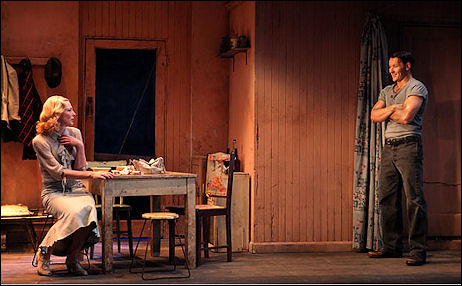“Most interpretations I’ve seen of Blanche DuBois, Tennessee Williams‘s greatest contribution to dramatic portraiture, ride the glistening surface of the character’s poetry, turning Blanche into a lyric, fading butterfly waiting for the net to descend,” says N.Y. Times theatre critic Ben Brantley in a review of BAM’s A Streetcar Named Desire. “What Cate Blanchett brings to the character is life itself, a primal survival instinct that keeps her on her feet long after she has been buffeted by blows that would level a heavyweight boxer.

Cate Blanchett, Joel Edgerton in BAM’s A Streetcar Named Desire.
“Blanchett’s Blanche is always on the verge of falling apart, yet she keeps summoning the strength to wrestle with a world that insists on pushing her away. Blanche’s burden, in existential terms, becomes ours. And a most particular idiosyncratic creature acquires the universality that is the stuff of tragedy.
“Blanche DuBois may well be the great part for an actress in the American theater, and I have seen her portrayed by an assortment of formidable stars including Jessica Lange, Glenn Close, Patricia Clarkson and Natasha Richardson. Yet there’s a see-sawing between strength and fragility in Blanche, and too often those who play her fall irrevocably onto one side or another.
“Watching such portrayals, I always hear the voice of Vivien Leigh, the magnificent star of Elia Kazan‘s 1951 movie, whispering Blanche’s lines along with the actress onstage. But with this Streetcar, the ghosts of Leigh — and, for that matter, of Marlon Brando, the original Stanley — remain in the wings. All the baggage that any Streetcar usually travels with has been jettisoned.
“[Director Liv] Ullmann and Ms. Blanchett have performed the play as if it had never been staged before, with the result that, as a friend of mine put it, ‘you feel like you’re hearing words you thought you knew pronounced correctly for the first time.'”












